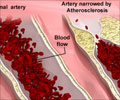John Laird, MD working as interventional cardiologist at the Washington Hospital Center studied the use of laser technique (ultraviolet energy) to restore blood flow in blocked arteries.
These blocked arteries are a big problem with people suffering from advanced diabetes as it leads to devastating complications such as amputation.People with diabetes and especially those with high blood pressure are at high risk for losing a limb because of severe diffuse atherosclerosis of the legs.
These patients were considered unfit for bypass surgery which is the standard treatment for the prevention of limb loss.
Diabetes is a leading cause of lower limb amputation in the U.S accounting for more than half of all foot and leg removals each year. According to the American Diabetes Association, 82,000 people lose a foot or leg to diabetes annually.
Previously conventional heat-guided lasers were used to burn away blockages. But this technique was too damaging to surrounding tissue and hence abandoned.
The new laser device, known as the excimer laser uses flexible fiber optic catheters to deliver short bursts of ultraviolet energy.
Advertisement
Following the laser procedure, balloon angioplasty is performed on almost all patients to help open the once-blocked artery.
Advertisement
Peter Sheehan, MD, specializes in the treatment of diabetes-related lower limb complications. He is director of the Diabetes Foot and Ankle Center for New York University Medical Center’s Hospital for Joint Diseases Orthopaedic Institute. He said that this laser is more and more used in patients at the highest risk.
Another catheter device, known as the SilverHawk plaque excision system, shaves blockages from artery walls with a tiny rotating blade and removes them from the body. But he adds that such procedures are not required in patients with less severe disease. They can be benefited from simpler methods such as changing the lifestyle with appropriate exercise, diet and taking proper medications.






